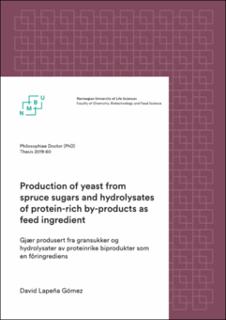| dc.description.abstract | The biotechnological potential and food-grade nature of yeasts are evidenced by their rich history of application in food fermentations. Thus, yeasts have been recognized as a suitable microorganism for the production of single cell protein (SCP). Production of yeast-based SCP could help meeting challenges derived from the combination of an increasing world population, limited protein availability and the need to upgrade by- products from different industries. Yeasts can utilize by-products from agriculture and forestry (lignocellulosic residues) and from food industries (by-products of meat and fish production) as carbon and nitrogen sources. Conversion of these feed stocks to yeast may not only improve protein availability in general, but could also have additional value, since yeast may have health-promoting effects. As an example, in aquaculture, yeast could replace fishmeal as a feed ingredient and/or reduce the dependency on plant-based proteins.
In the study described in this thesis, we have assessed by-products from different Norwegian industries for their potential to be used in the production of single cell protein from yeast for use in feed. The work included: 1) enzymatic hydrolysis of different meat and fish by-products using endogenous and exogenous enzymes, including a detailed characterization of the resulting hydrolysates and assessment of their potential as nitrogen source in growth media for yeasts, 2) screening of four selected yeasts as possible SCP source, using growth media composed of enzymatically hydrolysed poultry by-products and sugars derived from lignocellulosic biomass and 3) optimization and upscaling of yeast production using a semi-continuous fermentation strategy (repeated fed-batch fermentation), and use of different cell disruption methods to generate samples for future in vitro and in vivo trials.
Paper I describes a study of the enzymatic hydrolysis of three different by-products from Norwegian food industries: chicken by-products, mixed pork and beef by-products and salmon viscera. We used endogenous enzymes alone or in combination with commercial enzymes using short incubation times and a temperature gradient. Subsequently, hydrolysates were characterized by analysing the total recovery of protein, the peptide molecular-weight distribution, and the composition of total and free amino acids. The developed protocols entailed the combined use of endogenous and small amounts of commercial enzymes and yielded protein solublization levels up to 90%. The amino acid compositions of the hydrolysates generally seemed favourable for yeast production, which was confirmed by yeast growth studies.
The study described in Paper II demonstrates that it is possible to produce protein-rich yeast biomass using hydrolysates of sulphite-pulped spruce wood in combination with hydrolysates of chicken by-products, with yields similar to, and sometimes even better than when using commercial glucose and peptones. Initially, we screened growth of four different yeasts, Cyberlindnera jadinii (anamorph name Candida utilis), Wickerhamomyces anomalus, Blastobotrys adeninivorans (synonym Arxula adeninivorans) and Thermosacc® Dry (Saccharomyces cerevisiae), on ten different media in microtiter plates. Then, the performances of the most promising medium and a commercial rich medium were compared in batch fermentations using 2.5 L laboratory fermenters. Again, the spruce-chicken medium showed good performance and the fermentations showed B. adeninivorans (0.9 g cells and 0.5 g protein per g of sugar) and W. anomalus (0.6 g cells and 0.3 g protein per g sugar) performed better than well known Cyberlindnera jadinii (0.5 g cells and 0.3 g protein per g sugar) on this medium. Compositional analysis the produced yeast biomass included amino acid composition, and analysis of the contents of nucleic acids, minerals, lipids, carbohydrates and ash. The produced yeasts had favourable amino acid profiles, especially for amino acids considered to be essential.
Paper III describes a follow-up study to Paper II, where fermentation of three of the yeasts discussed in Paper II, Cyberlindnera jadinii, Wickerhamomyces anomalus, and Blastobotrys adeninivorans was partially optimized and upscaled from 1.5 to 25 L scale, using an aerobic repeated fed-batch strategy. The tested fermentation media composed of enzymatically saccharified sulfite-pulped spruce wood, enzymatic hydrolysates of poultry by-products and urea was optimized for the production of single cell protein. In this set-up, W. anomalus was the most effective candidate in terms of substrate consumption, yields of cells and protein, and productivity, whereas the repeated fed-batch procedure was least effective for B. adeninivorans. Upscaling of repeated fed-batch fermentation of W. anomalus on a medium where 80 % of the nitrogen source came from the poultry hydrolysate and 20 % from urea yielded 0.6 g of cell dry weight and 0.3 g of protein per gram of glucose, with cell and protein productivities of 3.92 g/L/h and 1.87 g/L/h, respectively. The protein content of the yeast biomass was 48 %, and the amino acid profiles were similar to those of fish and soybean meal, apart from low levels of sulphur-containing amino acids. Preliminary experiments to assess possible down-stream processing steps showed that W. anomalus cells were susceptible to commonly used disruptive methods, such as homogenization. Importantly, while there is still room for further optimization, the results of Paper III indicate that industrial production of W. anomalus in amounts required for its utilization in fish feed may indeed be technically feasible. | en_US |

